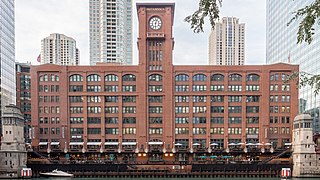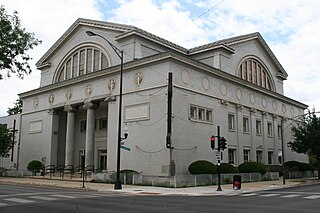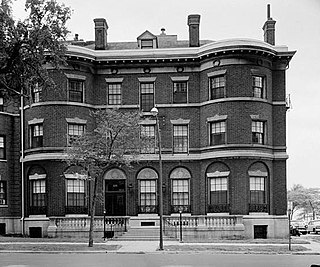
Knox's Headquarters State Historic Site, in the town of New Windsor in Orange County, New York, consists of the Georgian house of the Ellison family, built in 1754 by immigrant William Bull of Hamptonburgh, NY, and the grounds around it. The site is located on Old Forge Hill Road, just south of Route 94 east of Vails Gate.

Fort Omaha, originally known as Sherman Barracks and then Omaha Barracks, is an Indian War-era United States Army supply installation. Located at 5730 North 30th Street, with the entrance at North 30th and Fort Streets in modern-day North Omaha, Nebraska, the facility is primarily occupied by Metropolitan Community College. A Navy Operational Support Center and Marine Corps Reserve unit, along with an Army Reserve unit occupy the periphery of the 82.5 acres (33.4 ha) fort. The government deeded all but four parcels of the land to Metropolitan Community College in 1974.

The Reid, Murdoch & Co. Building, also known as the Reid Murdoch Building, the Reid Murdoch Center or the City of Chicago Central Office Building, is a seven-story office building in Chicago. It was constructed in 1914 and was listed on the National Register of Historic Places in 1975. It also has been designated as a Chicago Landmark. It is located at 325 North LaSalle Street in the River North neighborhood, alongside the Chicago River between LaSalle Street and Clark Street.

The Robert S. Abbott House is a historic house in the Grand Boulevard community area of Chicago, Illinois. Built about 1900, it was home from 1926 until his death of Robert S. Abbott (1870-1940), founder and publisher of the Chicago Defender, the largest-circulation African-American newspaper in the nation. Abbott started this newspaper in 1905 in which he heartened blacks in southern United States to move into north far from racist south. Abbott became one of the few self-made black millionaires in the early 20th century. His home was designated a National Historic Landmark status in 1976.

Immaculata High School was an all-girls Catholic high school located in the Lakeview neighborhood of Chicago, Illinois. It was open from 1921 to 1981.

Metropolitan Missionary Baptist Church, originally named the Third Church of Christ, Scientist, is a landmark church located on West Washington Boulevard in Chicago, Illinois, United States. The church was designed by architect Hugh M.G. Garden and was built in 1901. The church was sold to its current owners in 1947. It was designated a Chicago Landmark on February 16, 1989, and was listed on the National Register of Historic Places in 2016.

The West Jackson Boulevard District in Chicago, Illinois, also known as West Jackson Historic District, was listed on the National Register of Historic Places in 1978. It was earlier designed as a Chicago Landmark, in 1976, and expanded as Jackson Boulevard District and Extension in 1997. The NRHP district was expanded in 1989 to include one more building, the James H. Pearson House.

The King–Nash House, also known as Patrick J. King House, is a combination of Sullivanesque, Colonial Revival, and Prairie styles house in the East Garfield Park area of Chicago, Illinois, United States. The house was built in 1901 by George W. Maher for Patrick J. King. From 1925 until his death in 1943, it was home to Chicago political boss Patrick Nash.

The Gauler Twin Houses are two specular Prairie style houses located at 5917 and 5921 North Magnolia Avenue in Chicago, Illinois, United States. The houses were built in 1908 by Walter Burley Griffin for John Gauler, a land speculator. They were added to the National Register of Historic Places on June 17, 1977 and designated a Chicago Landmark on June 28, 2000.

The Groesbeck House is an Italianate style house located at 1304 West Washington Boulevard in Chicago, Illinois, United States. The house was built in 1869 by Otis L. Wheelock for Abraham Groesbeck. It was designated a Chicago Landmark on January 12, 1993.

The Lathrop House, also known as the Bryan Lathrop House, is a Georgian style house at 120 E Bellevue Place in the Gold Coast neighborhood of Chicago, Illinois, United States. The house was built in 1892 by McKim, Mead & White for Bryan Lathrop. In 1922 the house was sold to the Fortnightly Club. The club still occupies the building. It was designated a Chicago Landmark on May 9, 1973, and it was listed on the National Register of Historic Places in 1974.

The Roloson Houses, also known as the Robert W. Roloson Houses, are a group of four adjacent row houses in the Douglas community area of Chicago, Illinois, United States. The houses were designed in 1894 by architect Frank Lloyd Wright (1867-1959) for client Robert W. Roloson (1848-1925). Construction was begun in 1894 and completed in early 1895.

The Wheeler–Kohn House is a Queen Anne and Second Empire Style house in the Near South Side neighborhood of Chicago, Illinois, United States. The house was built in 1870 by Otis L. Wheelock for Calvin Wheeler.

Quinn Chapel AME Church, also known as Quinn Chapel of the A.M.E. Church, houses Chicago's first African-American congregation, formed by seven individuals as a nondenominational prayer group that met in the house of a member in 1844. In 1847, the group organized as a congregation of the African Methodist Episcopal Church, the first independent black denomination in the United States. They named the church for Bishop William Paul Quinn.

The F.F. Tomek House, also known as The Ship House or as the Ferdinand Frederick and Emily Tomek House, is a historic house in Riverside, Illinois. It is prominent example of Prairie School design by Frank Lloyd Wright. Designed in 1904 and construction finished in 1906, the Tomek House is a well-preserved example of the style. In addition to being a good example of the Prairie style, the Tomek house documents the development of the style, which reached its clearest expression in Wright's Robie House in 1908. It is included in the Riverside Historic District and was declared a National Historic Landmark in 1999.

The Edsel and Eleanor Ford House is a mansion located at 1100 Lake Shore Drive in Grosse Pointe Shores, northeast of Detroit, Michigan; it stands on the site known as "Gaukler Point", on the shore of Lake St. Clair. The house became the new residence of the Edsel and Eleanor Ford family in 1928. Edsel Ford was the son of Henry Ford and an executive at Ford Motor Company. The estate's buildings were designed by architect Albert Kahn, its site plan and gardens by renowned landscape designer Jens Jensen. The property was listed on the National Register of Historic Places in 1979, and was designated a National Historic Landmark in 2016.

This is a list of the National Register of Historic Places listings in Monterey County, California.

Prairie Avenue is a north–south street on the South Side of Chicago, which historically extended from 16th Street in the Near South Side to the city's southern limits and beyond. The street has a rich history from its origins as a major trail for horseback riders and carriages. During the last three decades of the 19th century, a six-block section of the street served as the residence of many of Chicago's elite families and an additional four-block section was also known for grand homes. The upper six-block section includes part of the historic Prairie Avenue District, which was declared a Chicago Landmark and added to the National Register of Historic Places.

Gifford Woods State Park is a state park located at the base of Pico Peak in Killington, Vermont. The wooded park provides camping, picnic, and fishing facilities, and has hiking trails, including a portion of the Appalachian Trail. It preserves an area of old-growth forest that has been designated a National Natural Landmark, and is accessible via an interpretive trail. The park was established in 1931. Part of it is listed on the National Register of Historic Places, for facilities developed by the Civilian Conservation Corps in the 1930s.






















